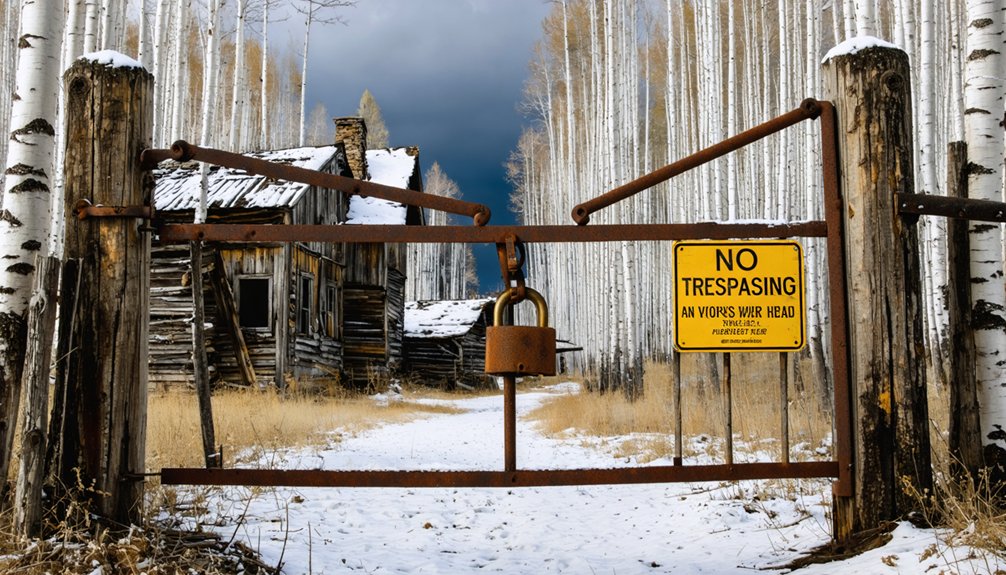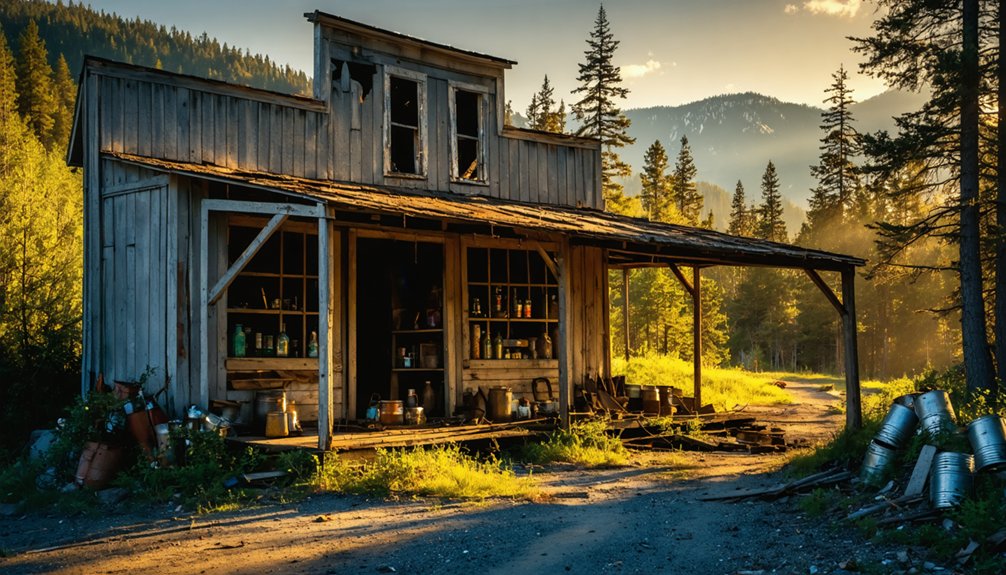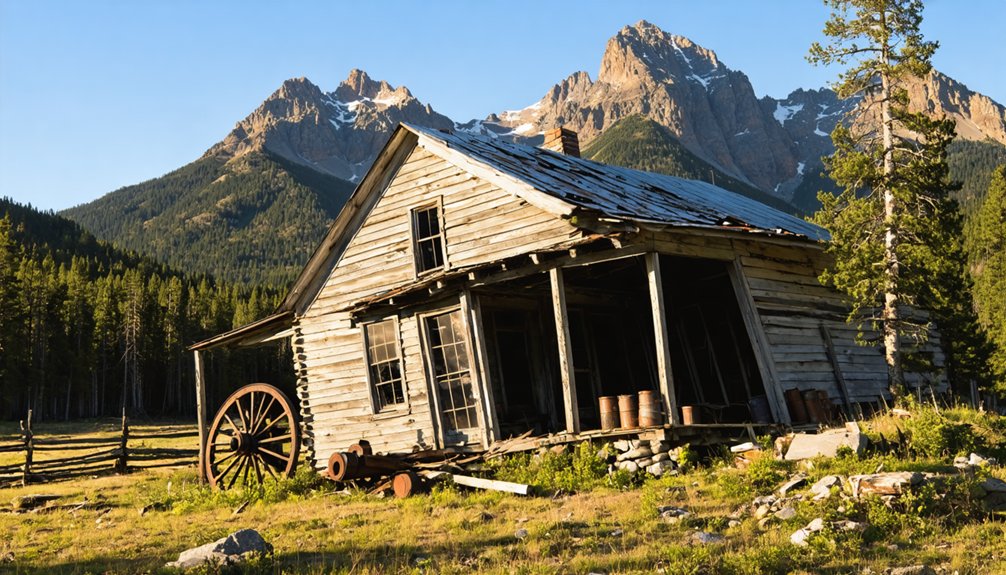You’ll find Graham ghost town deep in Idaho’s Boise National Forest, where a brief but intense 1885 silver mining boom created a thriving settlement. The town supported thirteen mines, six saloons, and a $350,000 mill before financial troubles led to its abandonment. Today, you can access the remote site via Edna Creek Road from mid-July to October, but you’ll need a four-wheel-drive vehicle and careful preparation to explore this fascinating piece of mining history.
Key Takeaways
- Graham became a ghost town after failed silver mining ventures in the 1880s, despite British investments totaling $600,000.
- Thirteen mining sites and a $350,000 mill operated briefly before financial collapse led to sheriff’s sales at severely reduced prices.
- The town once supported six saloons, five boarding houses, and a store during its peak before economic decline ended commercial activity.
- Access requires four-wheel-drive vehicles via Edna Creek Road, with visits limited to mid-July through October due to elevation challenges.
- Natural forces and forest fires have destroyed most structures, leaving only foundations and remnants of the former mining community.
The Challenging Journey to Graham
Although Graham’s ghost town beckons with its historical allure, reaching this remote site in Idaho’s Boise National Forest presents significant logistical challenges.
You’ll need to navigate Edna Creek Road, a rugged gravel route that crosses an 8,200-foot elevation pass, accessible only from mid-July through October due to snow conditions.
The difficult terrain demands a four-wheel-drive vehicle with low-range transfer case capabilities. A devastating major forest fire over a decade ago left the area with minimal remaining structures.
You’ll encounter steep grades, narrow passages, and unpredictable mountain weather challenges throughout your journey. Travelers should pack foul weather clothing and avoid exposed ridgelines during storms.
There’s only one way in and out, with no alternative routes available for motorized vehicles.
Given the site’s isolation and frequent road closures from fallen trees or weather damage, you must check current forest conditions and pack emergency supplies before attempting this adventurous trek.
A Silver Mountain Boom Town
The promising discovery of rich silver veins near Graham, Idaho in 1885 sparked immediate excitement throughout the region’s mining community.
You’d have witnessed a flurry of activity as assays revealed impressive silver values between $30 and $90 per ton in the richest zones, drawing prospectors and investors to this budding ghost town’s location.
British capital flowed into the silver mining operation through Matt Graham’s promotional efforts, enabling rapid development of the site.
You would’ve seen two shifts of determined miners driving a 240-foot tunnel to access veins 200 feet below ground.
The geology of the area featured rich deposits within the Belt series formations that characterized the region’s mineral wealth.
The mining operations reflected the broader success of Idaho’s Silver Valley, which would eventually produce over 1.2 billion ounces of silver throughout its history.
The nearby town of Atlanta, situated 16 miles southeast, fueled predictions of an impending mining rush as news spread of Silver Mountain’s potential wealth, attracting both fortune seekers and capitalists to the promising location.
Life in Graham’s Glory Days
Life in Graham’s mining heyday painted a vivid picture of frontier existence, with six saloons and five boarding houses forming the social backbone of this bustling silver town.
You’d find social interactions centered around these establishments, where miners gathered to drink, gamble, and share stories after long days of labor. The town even featured a Yankee Fork Herald newspaper that kept residents informed of local happenings. Like many other ghost towns in Idaho, Graham emerged during the 1860s mining boom.
Living conditions were decidedly primitive – you wouldn’t find modern amenities like running water or proper sewage systems. Instead, you’d share cramped quarters in wooden boarding houses, dining on simple, hearty meals designed to fuel hard work.
Miners endured basic living conditions, sharing tight spaces and eating plain meals while lacking essential modern comforts.
Your food options would’ve been limited, especially during winter months when supply trains couldn’t reach the isolated community.
The social hierarchy placed mine owners and engineers at the top, while most residents were transient workers moving with the ebb and flow of mining prospects.
Mining Operations and Infrastructure
During Graham’s peak mining period, you’d find thirteen active mine sites scattered throughout the area, each contributing to the town’s mineral production efforts.
The mining operations were supported by essential infrastructure including a substantial mill for processing ore and specialized equipment designed to maximize mineral extraction efficiency.
You could observe the careful engineering of a tramway transport system that facilitated the movement of ore from the mine sites to processing facilities, though financial constraints often limited its full utilization.
Mill and Processing Equipment
Mining operations at Graham centered around an ambitious $350,000 mill, constructed with expertise from British millwrights but destined for an extraordinarily brief operational life.
Despite its sophisticated mill design, you’ll find it operated for a mere eight to ten hours before processing challenges forced its closure. The mill’s swift demise reflects the broader struggles of the mining venture, which couldn’t sustain operations due to insufficient ore quality.
You can trace the mill’s dramatic financial collapse in its sale price – it was auctioned at a sheriff’s sale for just $9,500, a fraction of its construction cost.
Today, you’ll only find scattered remnants of this once-impressive structure, as a devastating forest fire has left little more than a rock wall and metal debris to mark its location. These historical remains are now part of the McCall Public Library Collection, preserved for educational study.
Tramway Transport System
The ambitious scale of Graham’s mining operation required efficient ore transport, leading to the construction of a mile-long tramway system by August 12, 1888. This tramway engineering marvel connected Silver Mountain’s remote mine workings directly to the $350,000 milling facility, enabling high-volume ore transportation that supported 150 workers and a twenty-stamp mill operation.
You’ll find the tramway’s design particularly remarkable for its time, featuring telephone lines along the route for coordinated operations and infrastructure capable of handling steep terrain challenges.
While the system drastically reduced dependence on slower wagon and mule transport methods, it couldn’t prevent the operation’s eventual financial collapse. By late 1888, the entire tramway infrastructure was auctioned for a mere $500 during a sheriff’s sale.
Thirteen Active Mine Sites
Contrary to its bustling past, Graham’s mining landscape today bears little resemblance to its historical activity, with no confirmed active mine sites in operation.
While Idaho maintains 2,661 mineral producers and over 40,000 mining claims statewide, none are specifically documented at Graham’s location.
You’ll find the Bureau of Land Management oversees 39 authorized mining operations across Idaho, but Graham isn’t among them.
Though the state’s mining sector continues to evolve with new infrastructure and processing facilities, these developments haven’t reached Graham’s historic grounds.
The broader region historically produced gold, silver, and lead, but current mining activities concentrate elsewhere.
Idaho’s 232,319 mining claims on public lands demonstrate significant mineral potential, yet Graham remains dormant.
Despite Idaho’s robust mining industry and the Critical Minerals Initiative spurring new projects, Graham remains inactive, preserving its ghost town status.
Recent developments like the Stibnite Gold Project highlight Idaho’s mining potential, but these ventures are located far from Graham’s boundaries.
The Swift Economic Collapse
Despite London’s initial $600,000 investment in Graham’s mining operations, the company’s refusal to provide additional funding triggered a cascade of financial troubles that culminated in devastating sheriff’s sales.
You’ll find stark evidence of the economic freefall in the sale prices, where a $350,000 mill fetched only $9,500, while thirteen mines and associated infrastructure sold for a mere $500.
The rapid business collapse manifested in the shuttering of Graham’s six saloons, single store, and five boarding houses, effectively ending the town’s commercial viability. The town’s decline mirrored many other Idaho ghost towns where falling metal prices contributed to reduced mining activities.
Investment Flight and Lawsuits
As London investors withdrew their promised £600,000 capital from North Boise mines in 1888, Graham’s economic foundation began to crumble. The legal repercussions were swift and severe, triggering multiple sheriff’s sales to satisfy mounting debts.
You’d have witnessed the dramatic devaluation of assets, as the $350,000 mill sold for a mere $9,500, while thirteen mines and associated infrastructure went for just $500 at auction.
The financial implications extended beyond immediate losses. When creditors forced liquidation, you could see the town’s rapid decline as businesses shuttered and residents fled.
The exodus of capital and labor left Graham fundamentally deserted by winter 1888, with only a watchman remaining to oversee the abandoned properties that once promised such prosperity.
Sheriff’s Sale Price Drop
The sheriff’s sale prices in Graham reflected the town’s swift economic unraveling, with property values plummeting far below their original worth.
You’d have witnessed residential and commercial properties facing markdowns of 30-40% as economic uncertainty gripped the region. Price trends showed multiple reduction cycles as demand collapsed and distressed properties flooded the market.
The impact rippled through Graham’s economy as businesses shuttered and unemployment surged. Sheriff’s sales became increasingly common while mortgage delinquencies rose and credit tightened.
With younger workers leaving and investors growing risk-averse, property values continued their downward spiral. The deteriorating infrastructure and reduced public services, stemming from shrinking tax revenues, only accelerated the decline, transforming once-valuable properties into deeply discounted assets.
Rapid Business Shutdowns
When Graham’s mining operations failed to produce viable ore despite $1 million in total expenditures, businesses rapidly collapsed throughout 1888-1889.
You’ll find that the economic consequences rippled through the community as unpaid workers departed en masse, leaving behind empty storefronts and abandoned services.
The Idaho Gold and Silver Mining Company’s insolvency triggered a chain reaction – the mill’s shutdown led to widespread layoffs, forcing support businesses to close their doors.
The community impact was devastating as creditors’ litigation further destabilized the local economy.
You’d have witnessed the rapid transformation from a bustling mining town to a ghost town, especially during the harsh winter months when remaining residents fled.
What had begun with British investment and high hopes ended in sheriff’s auctions and shuttered buildings.
Natural Forces and Lost Structures
Over the past decade, natural forces have dramatically reshaped Graham’s physical remnants, with a devastating forest fire reducing most structures to ashes throughout the valley and foothills.
Nature’s fury transformed Graham into ashes, as wildfire devoured the historic structures scattered across valley and hillside.
You’ll find the ecological impact particularly evident in the destruction of the mill, tram towers, and miners’ cabins, which were completely consumed by the flames. The area’s natural reclamation continues through harsh weather conditions, with cool winters and warm summers further deteriorating any surviving structures.
The rugged terrain presents additional challenges, as falling trees and early snowfall frequently close access roads.
While you can still identify some locations by remaining features like rock walls, the environment has largely reclaimed the site. Vegetation now thrives where buildings once stood, gradually obscuring the last traces of this historic mining town.
Seasonal Access and Safety Considerations

Since Graham’s remote location poses significant access challenges, visitors must carefully plan their trips around seasonal conditions.
You’ll need a four-wheel-drive vehicle to navigate the rugged mountain roads, which are only accessible during summer months when weather permits safe travel. Winter snow and adverse conditions make the site completely inaccessible.
Due to seasonal challenges and visitor safety concerns, you should prepare thoroughly for your journey.
Carry emergency supplies, including first aid kits, navigation tools, and extra water. Limited cell service and the potential for isolation mean you’ll need to be self-reliant.
Inform others of your travel plans, and avoid exploring unstable structures or visiting during adverse weather.
The site’s remoteness means emergency help could take hours or days to arrive, so exercise caution and respect the environmental hazards.
Notable Mining Investments
London’s capital played a pivotal role in Graham’s development, with British investors committing approximately $1,000,000 to the promising silver mining venture in the late 1880s.
You’ll find the most striking example of this investment in the modern $350,000 mill, completed in August 1888 and equipped with advanced British milling technology.
The peak investment period occurred between 1888 and 1889, though the venture’s rapid collapse led to the mill being auctioned for just $9,500 during the subsequent sheriff’s sale.
London’s Financial Influence
British investors played a pivotal role in Graham’s early development, committing substantial capital to mine and mill construction during the late 1880s. London investments exceeded $600,000 across the North Boise mines, with British carpenters and stonemasons spending two years building the district’s infrastructure.
Under the financial oversight of Vivian Thorne, who represented London’s interests on-site, the operation expanded to include gravity-powered bucket trams and extensive tunneling projects.
You’ll find that despite this massive investment, the venture quickly became overcapitalized. The British-backed development far outpaced the actual mineral potential, leading to devastating losses.
The $350,000 Mill
Among the most ambitious mining ventures in Graham’s history, the $350,000 mill stands as a demonstration of speculative excess and financial misjudgment.
British investors financed this advanced mining technology, importing skilled millwrights from England to construct what was considered a state-of-the-art facility for its time.
You’ll find it remarkable that this monument to economic speculation operated for only eight to ten hours before falling silent forever.
The mill’s fate became sealed when extensive exploration revealed no profitable gold or silver ore deposits, despite nearly $1,000,000 spent in the search.
Peak Investment Period
The peak investment period in Graham’s history showcased an extraordinary influx of capital, largely spearheaded by Matt Graham’s successful courtship of London financiers.
You’ll find that investment strategies during this era focused heavily on extensive exploratory work, with London capitalists committing $600,000 to the North Boise mines.
The Idaho Gold and Silver Mining Company, Ltd. implemented aggressive mining techniques, including the construction of a 500-foot exploratory tunnel and a 112-foot inclined shaft.
Two shifts of miners drove an additional 240-foot tunnel to strike the vein. English mining engineers recommended an ambitious 6,000-foot tunnel project, though it never fully materialized.
Despite these substantial investments and technical approaches, the lack of profitable ore ultimately led to the operation’s financial decline and eventual closure.
The Legacy of Graham’s Mines
Mining operations at Graham left an indelible mark on Idaho’s mineral frontier, characterized by ambitious development and substantial international investment.
Graham’s geology attracted significant attention, with mining techniques evolving from simple tunneling to sophisticated stamp mill operations.
You’ll find the lasting impact of these mines reflected in:
- Over $2.6 million in total mineral production, contributing to Idaho’s mining heritage
- Infrastructure development, including a $15,000 mountain road that opened remote areas
- British capital investment exceeding $1 million, establishing international financial connections
While the mines ultimately failed to meet profit expectations, they exemplify the era’s entrepreneurial spirit and technological advancement.
Though financial success proved elusive, Graham’s mines stand as monuments to frontier innovation and determined entrepreneurship.
The venture’s legacy lives on through the ghost town’s remains, telling a story of bold ambition and the volatile nature of frontier mining investments.
Tips for Modern-Day Explorers

Visiting Graham’s ghost town requires meticulous planning and proper equipment due to its remote, high-elevation location and challenging access conditions.
You’ll need essential exploration gear including a high-clearance vehicle, self-recovery equipment, and navigation tools. Pack emergency shelter, extra food, and water since there aren’t any services available along the route.
Critical safety tips: Check Boise National Forest’s current conditions before departing, as road closures are common from snow and fallen trees.
You’ll want to bring bear spray, warm layers, and a thorough first-aid kit. Plan your visit between mid-July and October when the 8,200-foot pass is typically accessible.
While documenting the site’s remaining foundations, respect private property boundaries and follow leave-no-trace principles.
Frequently Asked Questions
Are There Any Maps or Photographs of Graham From Its Mining Era?
You’ll find historical documentation’s a bit scarce, but McCall Library’s Ghost Towns folder and mining culture archives likely contain period maps and photographs, though they’re primarily accessible through in-person library visits.
What Happened to the Residents After Graham Was Abandoned?
You’ll find that most residents sought life after abandonment in nearby mining towns, while some returned to their original homes. Resident migration patterns weren’t well-documented beyond scattered oral histories.
Were Any Significant Silver Deposits Discovered After the Town’s Collapse?
You won’t find any significant silver discoveries in the area after Graham’s collapse. Historical records confirm that despite later regional mining activity, no profitable deposits emerged to revive the town’s mining impact.
Did Any Notable Historical Figures Visit or Invest in Graham?
You won’t find notable historical visitors in Graham’s records. While British investors had significant investment impact, the town lacked involvement from any famous American figures or national celebrities.
Are There Any Artifacts From Graham Preserved in Idaho Museums?
While Idaho’s museums house over 500 mining artifacts statewide, you won’t find confirmed Graham artifacts in public exhibitions. Local historical societies may have undocumented items, but specific Graham collections aren’t officially recorded.
References
- https://www.youtube.com/watch?v=P2JgcghKPKQ
- https://www.thegoldminehotel.com/ghost-towns-and-haunted-places-in-idaho
- https://history.idaho.gov/wp-content/uploads/2018/08/0066.pdf
- https://www.owyheejack.com/owyhee-jacks-meanderings/central-idaho/graham-banner-ghost-towns
- https://idaho-forged.com/idahos-ghost-towns-eerie-yet-approachable/
- https://1043wowcountry.com/idahos-own-atlantis-explore-the-underwater-ghost-town/
- https://www.lib.uidaho.edu/digital/mccall/items/mccall576.html
- https://www.ghosttowns.com/states/id/graham.html
- https://www.travelobscura.com/2017/02/14/a-secret-idaho-ghost-town/
- https://visitidaho.org/things-to-do/ghost-towns-mining-history/



